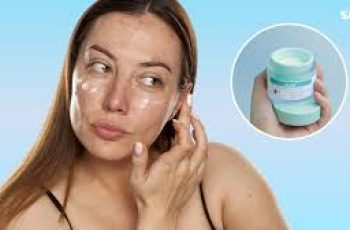Can mandelic acid be used daily?
It’s easy to understand why the idea of using an acid on your skin can be scary. Things get even more complicated when the acid in question isn’t as well-known as other acids, such as glycolic and salicylic acid. Mandelic acid isn’t necessarily a new ingredient, but it’s still so niche that it’s gone unnoticed because only the truly obsessed skincare fans know about its benefits and incorporate it into their skincare routines.
Don’t worry, because if you’ve always wondered what mandelic acid is and how it can benefit your skin, the next section is for you.
What is mandelic acid? And what are its benefits for skin?
Mandelic acid is a member of the AHA family, also known as alpha hydroxy acids. She’s descended from the others because she’s considered one of the gentlest.
It’s extracted from bitter almonds and formulated in a wide range of skincare formulas.
Exfoliates the top layer of the skin, removing all the accumulated dead skin cells, bacteria, dirt, debris, and other impurities.
It also penetrates deep into the pores to remove excess sebum, dirt, and bacteria that can cause blackheads and other skin imperfections.
Speeds up cell turnover and helps break down the bonds that hold skin cells together. By removing dead skin cells, the complexion appears brighter, more vibrant, and has a healthy glow.
Due to the additional increase in collagen production, fine lines and wrinkles are visibly reduced, and the skin feels firmer, helping to fight signs of aging.
Reduces the number of melasma spots on the skin and makes areas of hyperpigmentation appear brighter and more even-toned.
Has antibacterial properties and the ability to regulate the skin’s sebum production, making it an extremely useful ingredient for acne-prone skin.
If you want to learn more about the benefits of mandelic acid, read our dedicated blog post.
When shouldn’t mandelic acid be used?
Although mandelic acid is considered the gentlest of all acids, it can still cause irritation and increase the risk of allergies. To avoid this, I recommend avoiding combining mandelic acid with retinol, especially if you’re new to using both ingredients. If you plan to use mandelic acid for a chemical peel, completely avoid retinol two weeks before and one week after treatment.
You also shouldn’t apply mandelic acid to sunburned or tanned skin. This is because acids are too strong and can cause increased irritation, dryness, redness, and itching. While mandelic acid is gentle in nature, it’s best used in combination with a humectant like hyaluronic acid or niacinamide to lock in moisture and keep your skin healthy, happy, and hydrated.
If you have concerns about using mandelic acid or any other acid, seek help from a dermatologist or other healthcare professional to avoid unwanted side effects.
Can I take mandelic acid twice a day?
Yes, in fact, most skin care experts recommend using mandelic acid twice a day. This doesn’t mean you should start using it twice a day right away, but it does recommend using it once in the evening. Once your skin develops tolerance, you can use it twice a day.
Due to the antioxidant properties of mandelic acid, when applied to the skin in the morning, it protects the skin from damage caused by free radicals such as pollution, UV rays, and other environmental influences. When you reapply mandelic acid at night, the same antioxidant properties work on the damage that has already occurred. They repair and rejuvenate the skin while fighting signs of aging, loss of firmness, sun damage, and dull complexion.
Because everyone’s skin is different, not to mention how different our skincare routines are, it’s important to remember that what works for one person may not work for you. So if you try mandelic acid twice a day but find it’s too much for your skin, there’s nothing wrong with not using it once a day.
Does mandelic acid cause acne?
Yes, it is possible in the initial stages of getting into a routine. Also known as a “detox,” these breakouts are a common result of using chemical peels, especially if you’ve never had a chemical peel done on your skin before.
The reason for this clearing of the skin is that the skin cell turnover speeds up due to peeling, which clears out all the “residue” in the pores and the underlying skin is pulled out. Once impurities build up to the surface, blemishes such as blackheads, whiteheads, and active acne appear.
Clear skin can be daunting, but this is only a short-term issue as many people experience these results and clearer skin in up to two weeks. If you have other acne issues, it could be an allergic reaction. Therefore, I recommend that you stop using mandelic acid products and consult your doctor for further advice.
How should a mandelic acid routine be used?
A lot depends on which product the mandelic acid is formulated in. Because when it comes to skin care, there is a basic rule for the correct order of using products: start with the thinnest consistency and work your way up to the thickest formula. For example, start with a cleanser or face wash, toner, serum, face oil, moisturizer, and end with your daily SPF sunscreen. By taking care to use these products in the correct order, you can prevent the active ingredients from competing with the physical barrier created by thicker products on the skin’s surface. There you will learn more about the daily use of mandelic acid. If you still have any questions, you can contact me through our Instagram. We look forward to seeing you
DQH Knowledge drop: In your 20s, your skin cell turnover decreases. (Cell turnover is a key component in keeping your skin youthful.) You know what else slows down? Your collagen production. Starting in your 20s, collagen decreases by about 1 percent per year. Should you want to prevent fine lines and wrinkles, start by eliminating behaviors that contribute to premature aging. “If it’s bad for you, it’s bad for your skin,” says dermatologist Michel Somenek.
“Cigarette smoking reduces blood flow to the skin and causes premature wrinkling and a dull skin texture. Making the repeated pursed motion to inhale can also cause smoker’s lines. Alcohol and recreational drugs are toxins for the skin that damage its cellular structure and DNA,” Somenek tells us. “The faster you eliminate vices while you are young, the better chance your skin and body have to recuperate.” Also, adopting an anti-aging routine in your 20s is key. After all, the best offense is a good defense. We spoke to Somenek and experts Joshua Ross and Audrey Kunin to find out more.
Keep reading for the best anti-aging products for your 20s, according to skincare professionals.
Sunscreen
“We all know that the sun is the number one cause of skin aging and starting the prevention in your 20s is very important,” Ross says. “The majority of your sun damage won’t start to appear until you’re in your 30s, so don’t wait until you see it surface or you’ll be behind the curve. Stay ahead of it with a good-quality zinc-based sunscreen worn daily.”
Farmacy Green Defense Daily Mineral Sunscreen
An invisible sunscreen with SPF 30, plus botanical extracts meant to protect skin with tons of antioxidants. Bonus: It’s clean and fine to use under makeup.
Bareminerals Complexion Rescue™ Tinted Moisturizer Broad Spectrum SPF 30
Although we recommend you use your SPF and moisturizer separately, we also understand moments when you don’t have time or energy for that extra step. For those times, this bareMinerals moisturizer is a great thing to have on hand.
Vitamin C Serum
“A great introduction to anti-aging is to start with a vitamin C serum in your morning skincare routine,” Ross says. “It’s a powerful antioxidant that will neutralize free radicals and brighten the skin.” He adds that it’s a great way to counteract the effects of the sun’s harmful rays, which, as previously mentioned, are among the biggest causes of premature aging.
Drunk Elephant C-Firma™ Vitamin C Day Serum
The Drunk Elephant C-Firma is a lightweight serum that promises to give skin a glow by combining the brightening powers of vitamin C with ferulic acid, l-ascorbic acid, and vitamin E. The included sodium hyaluronate is meant to replace hydration loss, so you shouldn’t have to deal with any irritation.
Sunday Riley C.E.O. Rapid Flash Brightening Serum
This potent serum is jam-packed with vitamin C (15 percent, to be exact), which means it’s a potential superstar at both brightening skin and dousing it in antioxidants.
Peptides
Using peptides on your skin has many benefits, says Somenek. “The skin barrier is what defends the body against pollution, UV rays, bacteria, and toxins. It can be damaged by several everyday factors. Using topical peptides aids in building a stronger barrier,” he says. “Peptides comprise elastic fibers, which are a type of protein. These fibers help to make skin appear taut and firm. Peptides can also help repair damaged skin, relieve inflammation, and even out skin tone. Some peptides can kill acne-causing bacteria that is common in 20-somethings.”
Kunin agrees, saying, “Peptides are an excellent entry point for supporting collagen.” She recommends looking for face and eye treatments that contain these collagen-boosting powerhouses.
Charlotte Tilbury Magic Eye Rescue Cream
This Charlotte Tilbury super-emollient eye cream has a base of coconut oil and shea butter (read: it’s incredibly hydrating). Botanicals plus peptides are meant to help reduce dark circles and boost collagen, respectively.
This creamy moisturizer serves up potent collagen-boosting peptides and pycnogenol, and antioxidant-rich vitamin C. “Instead of sitting on top of the skin, peptides penetrate the outer layer so they go deep. The ‘signals’ they send tell the cells to produce elastin and collagen, which are needed for youthful-looking skin,” explains Somenek.
At-Home Peel Pads
Remember that skin cell turnover fiasco we talked about earlier? One way to help support it is by exfoliating. “Exfoliation is important to help keep skin fresh and luminous,” Kunin says. She recommends using at-home peel pads as an easy and effective way to exfoliate.
“The goal in your 20s is to fight the slowing pace of cell turnover. It is wise to use products that gently exfoliate, yet still remove oil and other impurities. Products that have Alpha Hydroxy Acids (AHA) or Beta Hydroxy Acids (BHA) are a good choice.”
According to Somenek, you should only exfoliate two to three times a week. “People of all ages are guilty of over-exfoliating and that can be too much of a good thing,” he says.
Dermadoctor Kakadu C Intensive Vitamin C Peel Pad
A few swipes of this Derma Doctor powerful peel pad promise to leave your skin glowing and smooth, thanks to the seven (yes, seven) types of chemical exfoliants, including AHA and BHA. It also contains vitamin C via Kakadu plum extract for added brightening and antioxidant protection.
KEY INGREDIENTS Kakadu plum extract is sourced from the Kakadu plum, a fruit grown in northern Australia. It contains vitamin C, which restores the skin’s natural barrier, increases collagen production, and soothes irritation.
Dr. Dennis Gross Skincare Alpha Beta® Universal Daily Peel Pads
These are the gold standard of peel pads, with a cult following and over 900 five-star reviews on Sephora. They’re easy to use and contain a blend of anti-aging exfoliating acids.
Emollient Night Cream
“In your 20s, you need to start upping the hydration in your skincare routine. You may have been cautious of over-moisturizing because of acne in your teens, but as you enter your 20s, your skin transitions and becomes drier,” Ross says. “I recommend an emollient night cream added into your evening skincare regimen.”
“Twenty-somethings need to make sure that they are not using creams that will clog their pores and cause excess oil production,” says Somenek. Opt for non-comedogenic products.
Cerave Skin Renewing Night Cream
One great choice is the CeraVe Skin Renewing Night Cream, which is a non-comedogenic night cream that leaves skin soft and glowy. It combines the moisturizing powers of ceramides and hyaluronic acid.
RoC Retinol Correxion Max Hydration Creme
“The best night cream ingredients contain retinol, benzoyl peroxide, and/or salicylic acid or hyaluronic acid. The goal is to moisturize, yet remove excess oil,” says Somenek. This Roc Retinol Correxion cream fits the bill as it contains both hyaluronic acid and retinol so it promises to moisturize while also being non-comedogenic.



